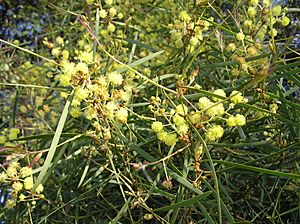Stringybark wattle facts for kids
Quick facts for kids Stringybark wattle |
|
|---|---|
 |
|
| Scientific classification | |
| Genus: |
Acacia
|
| Species: |
linearifolia
|
 |
|
| Occurrence data from AVH | |
The Acacia linearifolia, also known as the stringybark wattle or narrow-leaved wattle, is a type of shrub or tree. It belongs to the Acacia family and is found only in eastern Australia.
What Does It Look Like?
This wattle can grow quite tall, up to 10 meters (about 33 feet) high. It usually grows straight up, but sometimes its branches spread out. The bark is smooth and grey to grey-brown, but near the bottom, it often gets cracks or grooves.
Its branches are a dark reddish color and feel smooth. Sometimes, they might look a bit flaky. The plant has thin, smooth, green to grey-green phyllodes. These are like flattened leaf stalks that act as leaves. They are long and narrow, usually 6 to 12 centimeters (about 2.4 to 4.7 inches) long and 2 to 5 millimeters (about 0.08 to 0.2 inches) wide.
When the stringybark wattle blooms between August and October, it produces beautiful golden flowers. These flowers grow in round, tightly packed clusters, with about 20 to 26 flowers in each cluster. These clusters are found along flower spikes that are 2.5 to 6 centimeters (about 1 to 2.4 inches) long.
After the flowers, seed pods grow. These pods are reddish-brown and smooth. They can be up to 12 centimeters (about 4.7 inches) long and 5 to 7.5 millimeters (about 0.2 to 0.3 inches) wide. The pods often have bumps where the seeds are and are usually pinched in between the seeds. Inside, you'll find shiny black seeds that are oval-shaped and about 5 to 6 millimeters (about 0.2 inches) long.
Where Does It Grow?
The stringybark wattle is found naturally in the upper Hunter Valley region of New South Wales, Australia. You can see it in areas from Scone and Denman, New South Wales in the east, stretching towards Gulgong in the west. Sometimes, you might also find it further south, near Wagga Wagga.
This plant often grows on the lower parts of sandstone hills. It prefers rocky, sandy soils. It's a common part of dry sclerophyll forest and woodland areas, which are types of forests with tough, hard-leaved plants that can handle dry conditions.

